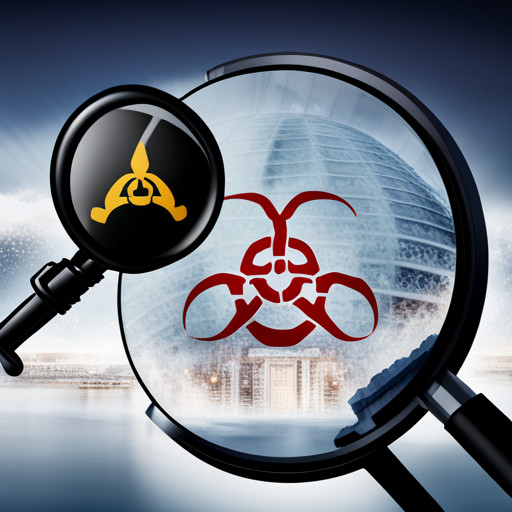Camp Lejeune Water Contamination Link to Lung Cancer
This article examines the correlation between lung cancer and water contamination at Camp Lejeune, a Marine Corps base.

It explores the role of public health agencies in establishing this link, the legal avenues for victims seeking compensation, and the potential value of their cases.
The impact of the PACT Act and CLJA on these lawsuits, as well as the analysis of previous settlements, is also discussed.
Key Takeaways
- The drinking water at Camp Lejeune was contaminated with high levels of chlorinated solvents from 1953 to 1987, exposing over 1 million people to the contaminated water.
- Studies conducted by public health agencies have found a significant increase in lung cancer rates among those exposed to the contaminated water, with the risk of developing lung cancer directly correlated to the level of exposure.
- The Agency for Toxic Substances and Disease Registry (ATSDR) and the National Research Council (NRC) have both found evidence linking the Camp Lejeune water contamination to higher rates of lung cancer.
- Congress enacted the PACT Act, allowing victims of Camp Lejeune water pollution to file tort lawsuits against the government with a lowered standard of proof for causation, potentially resulting in compensation for lung cancer cases.
The Tragedy of Camp Lejeune Water Contamination

The tragedy of Camp Lejeune water contamination unfolded between 1953 and 1987. During this time, the drinking water supply of the North Carolina Marine Corps base was polluted with high levels of chlorinated solvents. This contamination exposed over one million individuals to harmful chemicals significantly above safe limits, as established by the Environmental Protection Agency.
The impact on military families was staggering. They unknowingly consumed and used water contaminated with perchloroethylene (PCE) and trichloroethylene (TCE). The long-term health consequences of such exposure began to surface in the subsequent years, involving a range of serious illnesses including lung cancer.
This disaster served as a stark reminder of the critical importance of stringent environmental regulations and monitoring, especially in settings housing vulnerable populations such as military families.
Understanding Lung Cancer: An Overview

Understanding this complex disease requires a detailed look at its two primary types: small cell and non-small cell, each with distinct characteristics and survival rates. Small cell lung cancer is aggressive and spreads quickly, while non-small cell lung cancer grows and spreads at a slower rate.
In terms of understanding lung cancer prevention, it is crucial to identify risk factors such as smoking, exposure to radon gas, and hazardous substances. The latest advancements in lung cancer treatment include targeted therapy, immunotherapy, and precision medicine.
| Type of Lung Cancer | Survival Rate |
|---|---|
| Small Cell | 7% |
| Non-Small Cell | 23% |
These rates underscore the need for early detection and preventive measures to increase survival chances.
Unveiling the Connection: Camp Lejeune Water and Lung Cancer

Significant increases in rates of malignant pulmonary conditions have been observed among those subjected to prolonged exposure to the polluted drinking supply at a large Marine Corps base in North Carolina. The exploration of causation has indicated a direct link to the contaminated water supply and the long-term health effects experienced by those exposed.
- Studies have revealed a clear connection between this water contamination and increased rates of lung cancer.
- The risk of developing lung cancer is directly proportional to the level of exposure to the contaminated water.
- The Agency for Toxic Substances and Disease Registry has found a higher risk of lung cancer among those exposed.
- The National Research Council and the Veterans Administration have corroborated these findings.
- Legal implications have emerged, allowing victims to seek compensation for their suffering.
The Role of Public Health Agencies in Identifying the Link

Public health agencies played a pivotal role in identifying the correlation between exposure to polluted drinking water and increased rates of pulmonary diseases at a large Marine Corps base in North Carolina. Through a thorough investigation, these institutions conducted public health interventions, revealing the direct link between the consumption of contaminated water and higher instances of lung cancer.
The research findings, spearheaded by bodies such as the Agency for Toxic Substances and Disease Registry (ATSDR) and the National Research Council (NRC), unveiled a significant increase in lung cancer rates among those exposed to the polluted water.
The Veterans Administration (VA) corroborated these findings, recognizing lung cancer as a disease clearly associated with water contamination at the base.
Navigating the Legal Landscape: Lung Cancer Lawsuits at Camp Lejeune

Legislative actions have paved the way for individuals affected by toxic exposure to seek recourse through civil claims and compensation. The legal landscape surrounding Camp Lejeune's lung cancer lawsuits presents unique legal implications and compensation options.
The PACT Act and CLJA have been enacted, allowing victims to file lawsuits and have eased the burden of proof for causation. The potential value of claims remains uncertain, hinging on variables including settlement calculations and political climate.
Estimated average settlements range between $250,000 and $500,000. Wrongful death claims often lead to higher compensation.
Recent cases serve as reference points for understanding potential claim values, demonstrating the vast range of possible outcomes in these complex legal proceedings.
The PACT Act: A New Pathway for Justice

Enactment of the PACT Act has created new opportunities for victims of environmental toxic exposure to seek legal recourse and compensation. This legislation has led to a paradigm shift in the legal landscape, providing an avenue for individuals affected by the Camp Lejeune water contamination to pursue claims against the government.
The shift in legislation has also precipitated a change in the standard of proof required for causation, thus exploring legal implications further. This lowered threshold, known as equipoise causation, has made it significantly easier for plaintiffs to establish a link between the contaminated water and their injuries.
Consequently, more victims are seeking compensation, resulting in an increase in civil claims related to this catastrophic environmental disaster.
Evaluating the Potential Value of Camp Lejeune Lung Cancer Cases

Determining the potential compensation for victims of toxic exposure poses a significant challenge due to uncertainties in settlement calculations and the influence of the political climate.
The evaluation of Camp Lejeune lung cancer cases entails multiple factors:
- The severity of the victim's condition.
- The cost of medical expenses and potential future care.
- The age and life expectancy of the victim.
- The victim's income and earning potential.
- The pain and suffering endured by the victim.
Nevertheless, challenges in proving causation remain a hurdle in these cases, especially due to the latency period of lung cancer development. However, the lowered standard of proof under the CLJA provides some relief in this context.
Case Studies and Precedents: Analyzing Previous Camp Lejeune Settlements

Analysis of prior settlements provides valuable insights into the potential value and outcomes of lawsuits related to toxic exposure at military installations. A review of precedents, particularly those pertaining to Camp Lejeune, reveals patterns in legal approaches and compensation amounts.
The settlements reflect the severity of the harm caused by the exposure and the strength of evidence linking the exposure to the alleged health conditions. Factors such as the victim's medical expenses, loss of earnings, and pain and suffering are typically considered in determining the settlement value.
Analyzing these settlements contributes to understanding the potential outcome of future lawsuits. However, each case's uniqueness necessitates individual assessment. Therefore, while historical settlements provide guidance, they cannot guarantee future outcomes.
Frequently Asked Questions
What Measures Have Been Taken to Rectify the Water Contamination Issue at Camp Lejeune?
Efforts to rectify the water contamination at Camp Lejeune have involved the identification and elimination of contamination sources. Cleanup techniques utilized include groundwater treatment systems and soil vapor extraction.
These actions, mandated by the Comprehensive Environmental Response, Compensation, and Liability Act (CERCLA), aim to restore the affected environment to EPA's safe standards. Periodic monitoring continues to ensure the effectiveness of these remediation strategies and the maintenance of safe water quality.
Are There Any Ongoing Health Screenings or Monitoring for the Residents at Camp Lejeune?
Healthcare accessibility at Camp Lejeune has been improved with ongoing health screenings and monitoring programs for residents. These initiatives were implemented in response to the contamination timeline, spanning several decades, during which residents were exposed to harmful substances.
These proactive measures aim to detect potential health complications early, ensuring timely treatment and potentially reducing adverse health outcomes related to the historical water contamination incident.
What Other Health Conditions, Apart From Lung Cancer, Have Been Linked to the Water Contamination at Camp Lejeune?
Apart from lung cancer, the water contamination at Camp Lejeune has been associated with several other health conditions. These include kidney cancer, leukemia, non-Hodgkin's lymphoma, and liver disease.
The contamination timeline spans several decades, resulting in prolonged exposure for many individuals. Despite preventive measures implemented since the discovery of contamination, the long-term impact of exposure continues to manifest in various health anomalies among the exposed population.
How Can One Start the Process of Filing a Claim if They Were Affected by the Water Contamination at Camp Lejeune?
Initiating a claim process in the Camp Lejeune water contamination case necessitates certain prerequisites. Claim eligibility is determined by the period of exposure, the specific diseases developed, and valid documentation.
The compensation process involves presenting medical records, service history, and evidence of residence during the contamination period. Legal consultation is recommended for navigating the complexities of the process, including the PACT Act and the CLJA, which influence the outcome of such claims.
What Assistance Programs Are Available for Those Suffering From Lung Cancer Due to the Camp Lejeune Water Contamination?
Financial aid options for individuals suffering from lung cancer due to Camp Lejeune water contamination include:
- Compensation legislation like the Janey Ensminger Act. This Act provides healthcare for those affected by the contamination.
- The Camp Lejeune Families Act of 2012. This Act allows veterans and their family members to receive financial aid for medical conditions linked to the contamination.
- Various non-profit organizations also offer support services and financial assistance to victims of this disaster.
These options provide much-needed support and resources for those impacted by the water contamination at Camp Lejeune.




